When to Cash in on Your Winners
March 28, 2024
blog, cashing in profit from winning stocks, Investing Strategy, Portfolio Building, selling winners in your portfolio, when to sell your winner stocks, winners in your portfolio: when to sell
0 Comment
All investors share a goal. Making profit. How do you know when to cash in on your winners? A stock is up 20%-50%-75%. Will it keep going up? Is it about to crash? You feel you should sell, but you like that stock… Selling winners isn’t easy.
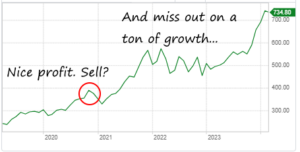
Some put a limit on the stock price gain, for example, when they’re up 50% they sell the position. As a dividend growth investor, I choose stocks I want to keep for a long time, not for a quick buck. When you hold on to solid holdings for a long time, you can get to triple-digit growth—much more interesting than 50% isn’t it? Patience can generate a lot more return than selling triggered by a cap on value appreciation.
That said, there are appropriate moments to cash in on your winners. Below, I’ll explain what I do to decide whether to sell, or trim, my winners.
Never miss a thing! Subscribe to our newsletter here.
Why sell?
I have two main reasons to sell a winning position or trim it of a few shares. The first is when my motives for buying the stock aren’t valid anymore. In other words, things have changed for the company and my thesis for investing in it in the first place is no longer true.
The other reason relates to portfolio management. When a position becomes too large, i.e., it’s overweight, my portfolio isn’t perfectly balanced, and my exposure to risk increases. Let’s look at these in detail.
Stock no longer fits my investment thesis

Every quarter, I review all holdings in my portfolio to see how they’re evolving with their most recent quarterly results. For each stock, I verify whether my investment thesis is still valid.
The investment thesis is the narrative, the story that explains why I bought the stock in the first place. It explains what I found compelling about the company and why I’d want to hold its stock forever (or 10 or 20 years).
For example, what made me confident and liked about Alimentation Couche-Tard (ATD.TO) is that: it was constantly growing by acquiring other convenience stores around the world, and also innovated to grow organically, for example, by selling fresh produce, coming up with new promotions, digital transactions, loyalty programs, etc.
During my review, I’ll see if this story changes. If ATD stops acquiring other companies or runs out of ideas for organic growth, I’ll flag it and I might eventually sell.
Backing it up with the numbers
During my review, I look beyond the narrative. Numbers. I review the dividend triangle to see the company’s trends for revenue, earnings, and dividend growth.

When the investment thesis no longer applies, looking at the triangle can confirm my suspicion that the stock isn’t as appealing as it once was. If I see revenue and earnings growth slowing down, dividend growth will likely slow down too, eventually. The company is not the company I bought originally.
I’m not trigger-happy. I don’t sell immediately following one poor quarter. However, if it’s one bad quarter after another, and my thesis isn’t right anymore, it’s time to sell and cash in my profit. Sticking to a quarterly review gives me great odds of being able to spot the issues and sell while the stock price is still high, making a nice profit.
Overweight sectors or positions
Should you cash in on your winners that still match my investment thesis and show good growth trends, as is the case with ATD.TO?
I like to let such winners run, but I might trim them if it’s needed. You see, my quarterly ritual includes reviewing my portfolio sector allocation and stock weight.
Am I overweight in a sector? If so, I could suffer a lot if a crisis happens in this sector. Remember tech stocks in 2000? I will trim winning positions in an overweight sector to rebalance the portfolio.
Overweight positions
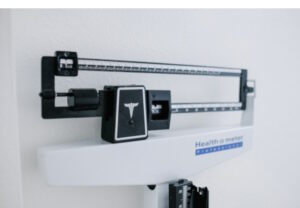
How can you tell you’re overweight on a single holding? That depends on two factors: how many stocks you want in your portfolio, and how much you are willing to lose on a single bad investment.
If you want 40 stocks, having equal-weighted positions means each stock should occupy 2.5% of your portfolio (100/40). If it’s 30 stocks, then each one would occupy 3.33% of your portfolio. You might let your favorite stocks exceed that maximum weight at 4% or more, with others occupying less than 3.33%.
As stock prices fluctuate, your stocks’ weight changes. Some winners can exceed the maximum weight by a lot. You can trim such positions right away by selling enough shares to get their weight back to where you want it.
But I love this overweight stock…

We get attached to our winners; I know. If your investment thesis for the company is still valid and the numbers back up your feelings, ask yourself how much you’re willing to lose on a single bad investment. Is it $5K, $10K, or $20K? You come up with this arbitrary amount based on your situation and risk tolerance. Let’s say it’s $20K and your portfolio is worth $800K; you’d be okay with losing (20/800*100) = 2.5% of your portfolio on a single bad investment
The worst that happens on the market is a ~50% crash of its value. We saw this when the tech bubble burst in 2000 and during the 2008 financial crisis. With that in mind, look at your overweight position: if it drops 50% in value tomorrow, is that loss lower or higher than 2.5% of your portfolio? If it’s more, time for a diet! Trim that position, even if you love the stock.
Knowing that the worst market loss is ~50%, and you’re okay losing 2.5% of your portfolio value, your maximum weight per stock is 5%. Trim any position that exceeds 5% to rebalance your portfolio and reduce risk.
Overweight winners are usually stocks that have performed well and gained value. Trimming them by selling a few shares lets you cash in on your winners while staying invested in the company to benefit from its future growth.
Liked what you read? Don’t miss anything. Subscribe to our newsletter here.
In retirement
If you are retired, you might have to cash in on your winners by selling a few shares to supplement your income. Perhaps your dividend income isn’t enough, inflation outpaced dividend growth in your portfolio, a holding cut its dividend, or extra expenses came up. Whatever the reason, these guidelines can help you choose which stocks to sell, how much to sell, and feel good about it.
The post When to Cash in on Your Winners appeared first on The Dividend Guy Blog.
All-Time High, Should I Buy? [Podcast]
March 27, 2024
Subscribe
Buying at all-time high is frightening for a lot of investors as a mistake becomes costly! Considering the current markets high prices; should you wait or should you buy? How to determine which stocks are worth a spot in your portfolio? Let’s talk about valuation, Dividend Discount Model (DDM), yield history, PE ratio trend, value score, payout ratios and more!
Subscribe to our newsletter to receive our best downloads, which include Top Stocks, Stock Lists, and the Workbook.
You’ll Learn
- We can’t do this episode without talking about valuation. To Mike, it is closer to fortune telling than science. Why is it so?
- Some tools become handy to know if a company deserves your money or not. One of them is the Dividend Discount Model (DDM), which assess the value of the future dividend payment. Mike summarizes its pros and cons (more details in video below).
- The yield history is also a good indicator of a stock valuation as it should be stable. However, context must be added.
- The PE Ratio trend also gives investors an idea of where the current price stands compared to the average.
- At Dividend Stocks Rock, we also use the Refinitiv Value Score. What is it made of and how useful is it?
- It seems like a lot of stocks are at their all-time high. Does it mean there is a higher risk of a correction?
- The answer to the question “Should I Buy at All-Time High”, is again, it depends! What does it depend on?
- To identify companies that will thrive, Mike first starts with the dividend triangle, which is positive Revenue, EPS and dividend growth.
- Why is dividend growth so important and how is it related to a high valuation?
- How do the payout ratio and cash payout ratio play a role in buying at all-time high?
- Mike ends with examples of companies at their all-time high that he would still buy in a heartbeat: Costco (COST), Home Depot (HD), and more!
Related Content
Let’s check out the Dividend Discount Model (DDM) usefullness and advantages, flaws and limitations!
We recently held an entire webinar around the topic of all-time high market. You can watch the free replay below.
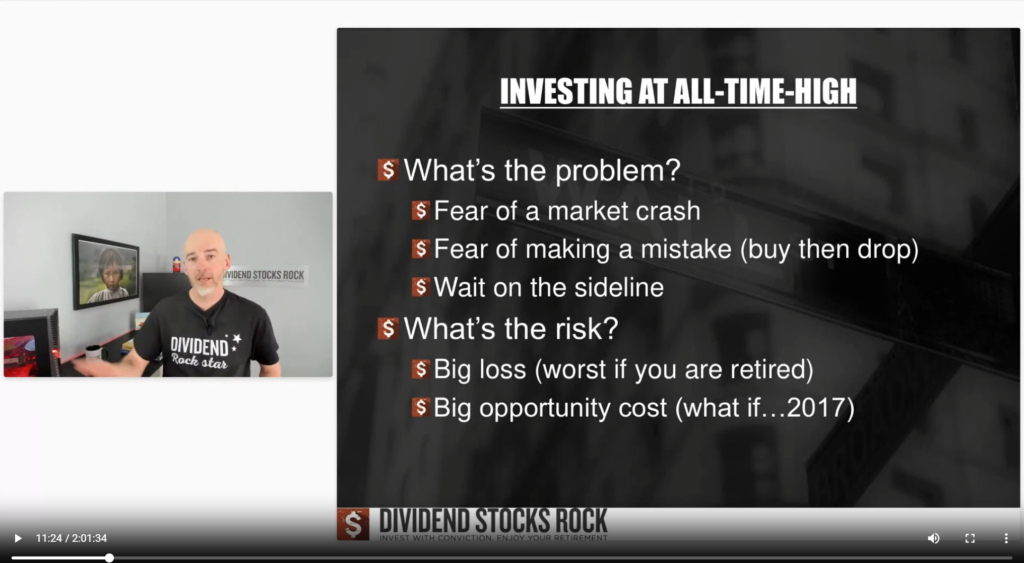
Subscribe
The Best Dividends to Your Inbox!
Download our Dividend Rock Star List now and do not miss out on the good stuff! Receive our Portfolio Workbook and weekly emails, including our latest podcast episode!
Follow Mike, The Dividend Guy, on:
- YouTube
Have Ideas?
If you have ideas for guests, topics for The Dividend Guy Blog podcast, or simply to say hello, then shoot me an email.
This podcast episode has been provided by Dividend Stocks Rock.

The post All-Time High, Should I Buy? [Podcast] appeared first on The Dividend Guy Blog.
4 Steps to Reduce Risk in a Near All-Time-High Market
March 21, 2024
all-time-high market: four steps to reduce risk, blog, market high: four steps to reduce risk, Portfolio Building, portfolio prep for next market crash or correction, portfolio: reduce your risks in near all-time-high market, Retirement, risk: reducing when market near all-time-high, Site Introduction
Four steps to reduce risk in your portfolio ahead of whatever happens next, and to keep investing confidently even with the current high market. Yes, the market is high, almost the highest in the last 34 years except during the tech bubble in 2000.
The Shiller CAPE ratio compares market earnings over time. It shows that the overall market is trading at nearly 31 times earnings. In other words, the entire market’s P/E ratio is 31. That’s expensive, and rattles a lot of investors.
Never miss anything! Subscribe to our weekly newsletter here.
What do we fear?
We fear what could happen next. A market correction around 10% isn’t that bad; it doesn’t take too long to bounce back. Market crashes, sharp drops of 20% or more, are more serious.
 Retirees and those near retirement worry about suffering a big loss. Those still investing money are afraid of investing just before a crash happens, and often wait on the sidelines.
Retirees and those near retirement worry about suffering a big loss. Those still investing money are afraid of investing just before a crash happens, and often wait on the sidelines.
Recognize yourself? Luckily, there are things you can do to ensure your portfolio is ready to weather the storm and to keep investing with confidence. After all, none of us know if, when, or by how much the market will crash; holding on to your money rather than investing it could cost you. Here are four steps to reduce risk and anxiety.
1 – Beyond the stock price…
You might be wondering whether some of your holdings are overpriced and at risk of crashing along with the market. You might also hesitate to invest more and paying too much. While some stocks are overpriced, others aren’t despite their high prices. If a company increases its earnings year-over-year, it’s normal that its stock price increases also.
The graph below shows the variation in the price-to-earning (P/E) ratio for Alimentation Couche-Tard (ATD.TO) and Microsoft (MSFT) over the last 10 years.
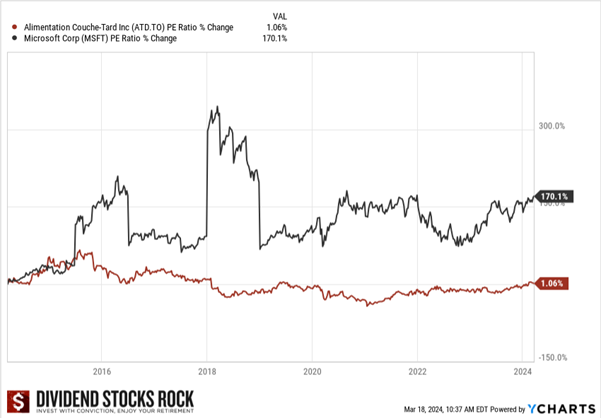
Over that period, ATD.TO’s price has gone from $14 to $80, but its P/E ratio has been pretty stable. In short, as the share price was rising, so were the earnings. To buy shares today, we’d pay almost the same multiple of ATD’s earnings as ten years ago. We can’t just look at the price to determine if a stock is overvalued.
Clarify valuation with these comparisons
What I do is compare the 5-year average P/E ratio against the Fwd P/E ratio, and the 5-year average dividend yield against the Fwd yield. For ATD.TO:
Average P/E ratio = 16.7 slightly below Fwd P/E = 18.15.
We’re paying a bit more now than the 5-year average, but not much when considering the stock’s 22.4% annualized dividend growth over five years, low payout ratio, etc.
Average yield = 0.9% slightly higher Fwd yield = 0.7%,
This also indicates a small premium on the current stock price, but again, not much.
In the graph, we see that Microsoft’s P/E ratio grew 170% over 10 years. Overpriced? Not so fast. Due to cloud computing and AI, the market expects MSFT’s growth to continue and is willing to pay a premium for the stock. Of course, the market could be wrong. If MSFT fails to continue growing at its current pace, its stock price could easily drop 10%.
Comparing MSFT’s Fwd P/E ratio and Fwd yield with their respective 5-yr average shows results similar to ATD’s—a slight increase in valuation vs. five years ago. The bulk of the 170% P/E ratio increase was driven by a high valuation in the five years of that period when MSFT wasn’t yet benefiting from cloud computing and AI.
A Fwd P/E ratio much higher than the 5-year average, and a Fwd yield much lower than the 5-year average, can indicate an overpriced stock, or not. In such a scenario, I’d try to find out why the market is valuing the stock so high.
Never miss anything! Subscribe to our weekly newsletter here.
2 – Measure your exposure to risk
Having a suitable exposure to risk is essential to protect your nest egg. That means diversifying across sectors and having appropriate weight for individual stocks.
Sector allocation
Ensure you have holdings in several sectors and not too much of your portfolio in a single sector. Having 45% invested in a single sector overexposes you to the risks the sector faces. If that sector crashes, 45% of your portfolio will drop.
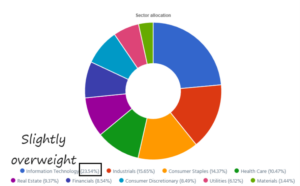 I usually limit my exposure to a single sector to 20% for my favorite sectors and up to 10% for other sectors. Retired or nearly retired investors might tailor their sector allocation to favor stable and income-producing sectors while keeping a smaller portion of their money in growth sectors.
I usually limit my exposure to a single sector to 20% for my favorite sectors and up to 10% for other sectors. Retired or nearly retired investors might tailor their sector allocation to favor stable and income-producing sectors while keeping a smaller portion of their money in growth sectors.
See How Sectors and Industries Guide Investors.
Stock weight
How much are you willing to lose on a single stock in your portfolio…2%, 3%, 5% of your portfolio’s value?
Once you’ve answered that, look at your largest positions and their weight in your portfolio. During the worst market crashes in the last 40+ years, the market lost roughly 50% of its value before stabilizing and beginning to recover.
For example, let’s say you can tolerate a loss of 5% of your portfolio. If you have a $1M portfolio, you’re okay with losing $50,000 on a single stock. If that loss is from a 50% crash, the maximum amount for this position is $100,000.
If you have a holding worth over $100,000, it’s time to trim that holding. Sell some shares to decrease your exposure and reallocate the funds elsewhere to spread your risk.
3 – Focus on quality
Ensure your holdings are quality stocks. It’s alright to hold on to quality stocks even if a market crash drags them down tomorrow. They’ll bounce back faster than poor-quality holdings and reward you.
A quality holding shows:
 A very strong dividend triangle, with a consistent growth trend for revenues, earnings, and dividends.
A very strong dividend triangle, with a consistent growth trend for revenues, earnings, and dividends.- An investment thesis that explains how the company will be able to keep increasing its revenue and earnings over the next 5, 10, or 20 years, e.g., growth vectors, sticky business models, predictable cash flow, etc.
When you’re worried about a crash, it’s not the time to take wild guesses on holdings you’re unsure of. If you’re keeping stocks hoping that they’ll bounce back, but you don’t have a clear investment thesis for them, consider getting rid of them, or at least some of them.
4 – Dividend safety first
In a market crisis, many companies cut their dividend. Assess the dividend safety of your holdings and ensure your dividend income is diversified.
 To assess dividend safety:
To assess dividend safety:
- Look for low to moderate payout ratios that indicate the companies make more profit than what they pay out in dividends. See Using Payout Ratios Wisely.
- Look for a trend of dividend growth over several years.
When you see a high yield, no dividend growth or slowing dividend growth, a high payout ratio, and a weak dividend triangle, you can expect a dividend cut.
Diversification of your dividend income across several holdings makes it less painful if one of your holdings cuts its dividend. Ensure you don’t depend on one or two companies for 25% of your dividend income, especially if you’re retired or near retirement.
Make sure your dividend income comes from companies in different sectors or industries. In other words, don’t invest in 10 REITs, or 6 Canadian banks; throw in some utilities, consumer staples, telcos, etc.
Using these four steps to reduce risk will help you sleep well at night, whatever happens on the market.
Waiting on the sidelines?
You have money to invest but you’re waiting for the “imminent” market crash?
We never know when a market crash will happen and when it does happen, we don’t know when we’ve hit rock bottom. You could end up waiting a long time, all the while missing out on dividend payments.
If you’re worried about investing at peak prices the day before the worst crash in a decade, plan to invest at intervals, e.g., monthly, quarterly, to minimize that risk. Learn more about this in How to invest lump sum. Using these four steps to reduce risk and also to invest new money wisely, at any time!
The post 4 Steps to Reduce Risk in a Near All-Time-High Market appeared first on The Dividend Guy Blog.
Weak Dividend Triangle = Sell? [Podcast]
March 20, 2024
Subscribe
It’s easy to understand a positive dividend triangle, but how to explain a weak one? This episode was inspired by a webinar attendee who asked what to do with a Dividend Triangle showing a negative EPS. Should you sell on downward trends, red flags, and suspicious numbers? Let’s find answers!
Don’t Miss Tomorrow’s Webinar on Investing at All-Time High Market! Click to Save Your Spot!
You’ll Learn
- We can’t start this episode without a reminder of what is the dividend triangle, which is positive 5-year revenue, EPS, and dividend growth.
- Mike explains how he uses the Dividend Triangle as a first set of filters to select dividend growers.
- However, there are times when a good company may show a weaker dividend triangle and this is what we’ll look at today. First, what should we do if one metric goes down?
- Revenue can fluctuate from a quarter to another. How should investors analyse it?
- Vero asks the question that inspired this episode. What does a negative EPS growth mean on the dividend triangle?
- Some companies show a negative EPS growth but remain strong. It is the case for Brookfield Corporation (BN) and TD Bank (TD).
- What does it mean when dividend growth slows down? Is this a sell sign?
- The payout ratio is another metric that can help assess the dividend growth health. Mike explains how using the right one will add analysis context for investors.
- In the end, when does a weak triangle become a sell sign? In short, you need to be able why numbers are going down…
- Would Mike buy a stock with a weak dividend triangle? Is this a buying opportunity?
Related Content
Mike shared the bear case of Brookfield Corporation (BN) on The Moose on the Loose podcast.
Investors’ main struggle remains how or when to buy and sell. Here are four tools (and a bonus!) to do it without regrets!
4 Tools to Buy and Sell With No Regrets [Podcast]
More details about the Dividend Triangle are included in the article below.
Detect Losers and Find Winners with The Dividend Triangle
Quick Note on the Upcoming Webinar
On Thursday, March 21st, I’ll be hosting a free webinar on positioning your portfolio in an all-time-high market.
After this webinar, you should be able to:
After this webinar, you should be able to:
- Make the difference between price anchoring and sound valuation.
- Fight your fear of investing now and losing money.
- Get the deal you are looking for.
- Buy dividend stocks in an overvalued market without getting burned.
Here are the complete details:
- The webinar is on Thursday, March 21st at 1pm ET.
- It is 100% free, no strings attached.
- The presentation is about 50 minutes.
- I’ll stay for one hour to answer all your questions.
- I’ll provide the handouts to all live attendees.
- A free replay link will be sent to all registered attendees.
Prepare your questions. This webinar is about 50 minutes long, and I will answer all your questions about stocks, strategies, and the economy afterward.
Save Your Spot to Our Next Webinar on Investing at All-Time High Market!
The Best Dividends to Your Inbox!
Download our Dividend Rock Star List now and do not miss out on the good stuff! Receive our Portfolio Workbook and weekly emails, including our latest podcast episode!
Follow Mike, The Dividend Guy, on:
- YouTube
Have Ideas?
If you have ideas for guests, topics for The Dividend Guy Blog podcast, or simply to say hello, then shoot me an email.
This podcast episode has been provided by Dividend Stocks Rock.

The post Weak Dividend Triangle = Sell? [Podcast] appeared first on The Dividend Guy Blog.
Markets Performance Review – February Dividend Income Report
March 14, 2024

In September of 2017, I received slightly over $100K from my former employer, representing the commuted value of my pension plan. I decided to invest 100% of this money in dividend growth stocks.
Each month, I publish my results on those investments. I don’t do this to brag. I do this to show my readers that it is possible to build a lasting portfolio during all market conditions. Some months we might appear to underperform, but you must trust the process over the long term to evaluate our performance more accurately.
Quick Note on the Upcoming Webinar
On Thursday, March 21st, I’ll be hosting a free webinar on positioning your portfolio in an all-time-high market.
After this webinar, you should be able to:
After this webinar, you should be able to:
- Make the difference between price anchoring and sound valuation.
- Fight your fear of investing now and losing money.
- Get the deal you are looking for.
- Buy dividend stocks in an overvalued market without getting burned.
Here are the complete details:
- The webinar is on Thursday, March 21st at 1pm ET.
- It is 100% free, no strings attached.
- The presentation is about 50 minutes.
- I’ll stay for one hour to answer all your questions.
- I’ll provide the handouts to all live attendees.
- A free replay link will be sent to all registered attendees.
Prepare your questions. This webinar is about 50 minutes long, and I will answer all your questions about stocks, strategies, and the economy afterward.
Save Your Spot to Our Next Webinar on Investing at All-Time High Market!
Performance in Review
Let’s start with the numbers as of March 1st 2024 (during the day):
Original amount invested in September 2017 (no additional capital added): $108,760.02.
- Portfolio value: $249,809.27
- Dividends paid: $4,530.76 (TTM)
- Average yield: 1.81%
- 2023 performance: +20.69%
- SPY= +26.19%, XIU.TO = +11.87%
- Dividend growth: +1.7%
Total return since inception (Sep 2017 – March 2024): 129.69%
Annualized return (since September 2017 – 78 months): 13.65%
SPDR® S&P 500 ETF Trust (SPY) annualized return (since Sept 2017): 13.60% (total return 129.100%)
iShares S&P/TSX 60 ETF (XIU.TO) annualized return (since Sept 2017): 9.15% (total return 76.63%)
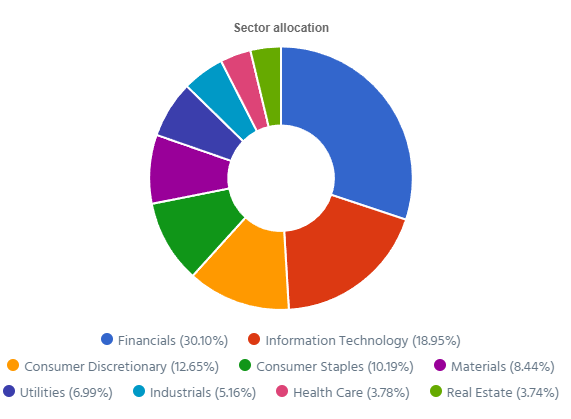
Markets Performance Review
From time to time, I use my portfolio update to do a quick market review of both the U.S. and Canadian stock market’s performance.
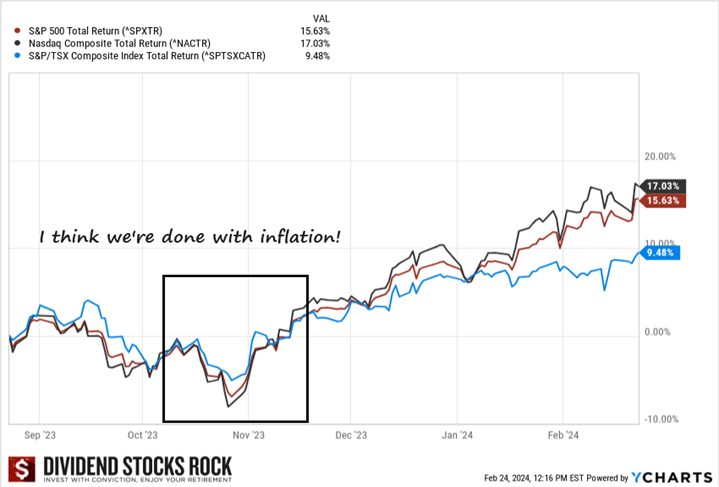
I discussed the inflation and interest rate themes at length in 2023. While it’s impossible to know how this story will end (smooth landing or recession?), I’ve often stated that once investors believe we are finished with inflation and done with interest rate hikes, we will see the markets resume their upward movement.
We got the first hints towards the end of October 2023. Since then, the market has been pushing higher and higher while we haven’t yet seen the first interest rate cut. Ironically, it seems that Wall Street and Bay Street expect a lot more from the FED and the Bank of Canada than what’s on the central banks’ play book for 2024.
My guess? The market and its followers will be disappointed as the months go by this year.
Are Markets Overvalued?
This brings us to the eternal question: “are markets overvalued?”. After all, we don’t expect a major earnings surge in 2024 as many companies will deal with an economic slowdown. Many retailers and transportation companies have raised red flags toward the end of 2023 and are not that optimistic for 2024.
When we look at the S&P 500 Shiller CAPE ratio, we are “in line” with what we have seen since 2017. However, please keep in mind that in 2017 the market was trading at an all-time high and many thought the market was overvalued back then.
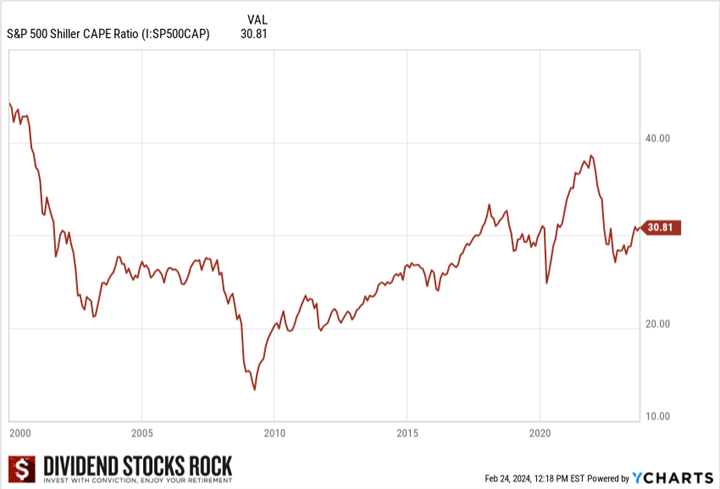
The Shiller CAPE ratio is calculated by dividing the current market price of the S&P 500 index by the average of the last 10 years of earnings, adjusted for inflation. This adjustment for inflation allows for a more accurate comparison of earnings over time ensuring that the ratio reflects real changes in valuation, and not just changes in the price levels.
31 times earnings seem expensive. Correction; it is expensive!
Does it mean you should sell everything and wait for a market crash? Ah! Imagine if you had done that in 2017…
I prefer to focus on quality companies that will continue to increase their dividends over time. It’s easier to apply and it generates better returns. In the meantime, what I read is high expectations from investors.
- Investors expect interest rate cuts and hope it will drive economic growth.
- They also expect a lot from artificial intelligence (more growth, more profit, and also ways to help “older” companies to cut down their operation costs).
As you know, the stock market is a voting machine. Right now, all votes are for growth. If it doesn’t happen, then you can expect a correction in the best-case scenario (market down around 10%) or a bear market (down by more than 20%) if we don’t get enough rate cuts.
Again, the focus on dividend growers appears to be one of the best approaches to achieving my financial goals.
U.S. Market Review
I’ve discussed with many DSR members the relevance of selecting specific holdings while you can simply invest in the S&P 500 and get amazing results. Let’s be honest: it’s incredibly difficult to beat the S&P 500. As of late, it has gotten even harder to beat it. Why?
Because most of the S&P 500 return is driven by the Magnificent Seven. This is a small group of tech stocks driving the entire index to whole new levels. They are able to affect significantly the performance of the entire market as they move higher quickly and represent 29% of the index (as of February 23rd 2024):
- Apple (AAPL): 6.30%
- Microsoft (MSFT): 7.15%
- NVIDIA (NVDA): 4.53%
- Amazon (AMZN): 3.71%
- Alphabet (GOOGL, GOOG): 1.99% + 1.69% = 3.68%
- Meta (META): 2.52%
- Tesla (TSLA): 1.28%
On one hand, those companies drove exceptional results. Not having them in your portfolio makes it very difficult to beat the S&P 500 performance.
On the other hand, concentration in technology-related companies is a high risk. If they fail to perform, your retirement could be at risk.
What’s the solution? The efficiency and magic of diversification!
You are wrong if you think that matching or beating the market should be your objective. You should focus on how much return you need constantly to achieve your financial goals.
Chasing returns will force you to jump from one strategy to another. To always chase the strategy that generated the best return… last year, over the last 3 years or the last 5 years. How can you know that this is the strategy that will do well going forward?
As a quick example, you can see how the Energy sector isn’t the solution for growth anymore (but it was for two consecutive years!).
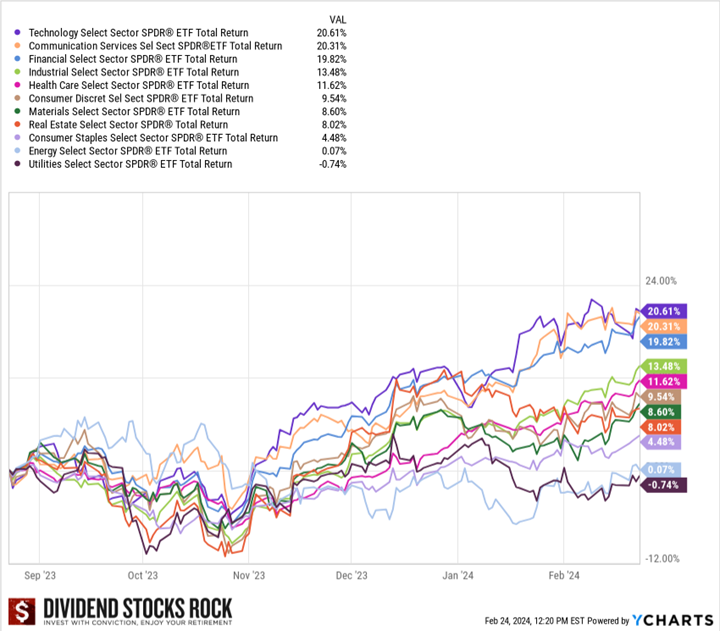
The U.S. market has been driven by tech stocks and most companies in the communication services pushing this sector ETF through the roof are companies like Alphabet and Meta. Another sector doing well is the financial sector. It makes sense as asset managers did benefit from a strong market in 2023 (if the market goes up, assets under management follow and so do the fees paid to asset managers). Banks should do better as interest rate revenues will continue to be stable and we have better chances of avoiding a recession if we start cutting rates pre-emptively.
What’s New in Maply Syrup Country?
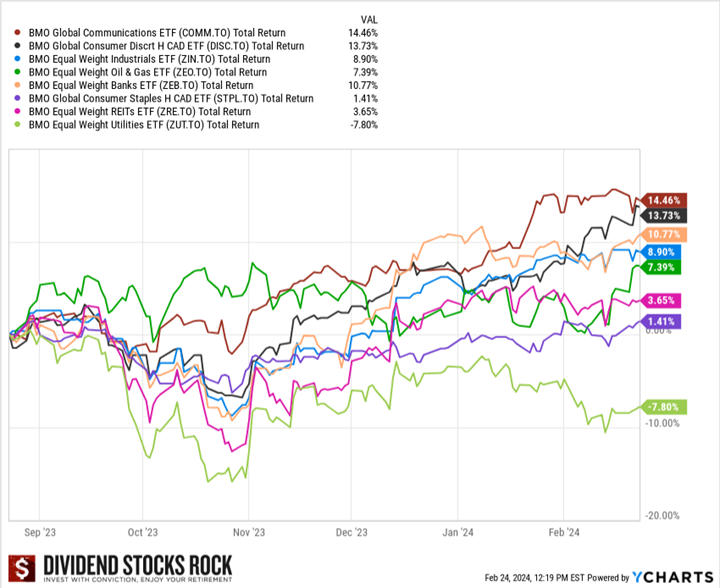
Utilities continue to suffer as the interest rates are not their friend and renewable energy utilities can’t seem to get any love from the market. Consumer staples are sobering up and maybe investors have realized that while grocery stores are great foundation stocks for a sleep-well-at-night portfolio, their growth potential is limited due to heavy competition.
Inflation seems to be under control as it slowly but surely gets closer to the magical target of 2%. This means banks should have a break and could hope for better days in 2025. In the meantime, it’s obvious that the economy is slowing down. We have seen many companies (notably Canadian Tire, Canadian Pacific and Canadian National Railway) explaining that their results have been affected negatively by weaker consumer spending.
While the U.S. market seems overpriced, the Canadian market hasn’t surged as high. There might be more opportunities up north for the time being. However, this doesn’t mean buying all high yielding stocks thinking they will recover magically. Keep in mind there is a reason why Scotiabank offers about 2.5% more yield than National Bank.
While I’m building my Smith Manoeuvre portfolio, I find it difficult to select companies offering a yield above 4% coming from various industries. I’m even starting to think that I’ll lower my overall yield by adding a few more low-yield, high-growth positions in 2024. The goal will be to improve total return, benefit from the leverage impact and also to select companies that are in a better position to face a potential recession.
Smith Manoeuvre Update
Slowly but surely, the portfolio is taking shape with 10 companies spread across 7 sectors. My goal is to build a portfolio generating 4-5% in yield across 15 positions. I will continue to add new stock monthly until I reach that goal. My current yield is 5.05%.
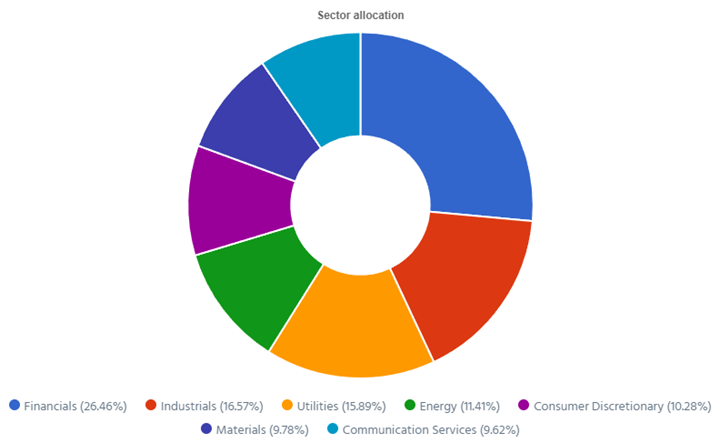
Adding more of Exchange Income (EIF.TO)
Exchange Income reported a solid quarter with revenue up 21% and EPS up 12%. Revenue in the Aerospace & Aviation segment increased by $45 million or 13% while revenue in the Manufacturing segment increased by $68 million or 34%. This growth was partially attributed to strategic acquisitions and continued investment in operating subsidiaries, demonstrating the success of EIC’s strategy to nurture and invest in acquired companies with excellent management teams. IN 2023, EIF made substantial growth capital investments, particularly in the Aerospace and Aviation segment which should drive growth in 2024 and beyond.
Here’s my SM portfolio as of March 1st, 2024 (during the day):
| Company Name | Ticker | Sector | Market Value |
| Brookfield Infrastructure | BIPC.TO | Utilities | $907.40 |
| Canadian National Resources | CNQ.TO | Energy | $1,080.42 |
| Capital Power | CPX.TO | Utilities | $578.85 |
| Canadian Tire | CTA.A.TO | Consumer Disc. | $966.70 |
| Exchange Income | EIF.TO | Industrials | $1,555.20 |
| Great-West Lifeco | GWO.TO | Financials | $714.85 |
| National Bank | NA.TO | Financials | $641.76 |
| Nutrien | NTR.TO | Materials | $935.35 |
| Telus | T.TO | Communications | $903.64 |
| TD Bank | TD.TO | Financials | $1,139.60 |
| Cash (Margin) | -$32.48 | ||
| Total | $9,358.81 | ||
| Amount borrowed | -$9,000.00 |
Let’s look at my CDN portfolio. Numbers are as of March 1st, 2024 (during the day):
Canadian Portfolio (CAD)
| Company Name | Ticker | Sector | Market Value |
| Alimentation Couche-Tard | ATD.B.TO | Cons. Staples | $25,172.81 |
| Brookfield Renewable | BEPC.TO | Utilities | $8,446.92 |
| CCL Industries | CCL.B.TO | Materials | $9,830.80 |
| Fortis | FTS.TO | Utilities | $8,922.78 |
| Granite REIT | GRT.UN.TO | Real Estate | $9,433.60 |
| Magna International | MG.TO | Cons. Discre. | $5,146.40 |
| National Bank | NA.TO | Financials | $12,934.90 |
| Royal Bank | RY.TO | Financial | $8,615.75 |
| Stella Jones | SJ.TO | Materials | 10,698.88 |
| Cash | $561.62 | ||
| Total | $99,764.46 |
My account shows a variation of +$1,172.26 (+1.19%) since the last income report on February 5th.
Many companies reported their earnings in February, let’s have a look!
Brookfield Renewable keeps growing
Brookfield Renewable reported a solid quarter with FFO per unit growth of 9% for the quarter and +7% for the year. Management also announced a 5% dividend increase! The results reflect the benefit of BEP’s diverse asset base, high-quality inflation-linked and contracted cash flows, organic growth, and contributions from acquisitions. In 2023, BEP secured contracts for new developments for almost 50 terawatt hours, 90% is with corporate customers. BEP keeps growing as it deployed (or agreed to deploy) $9B in capital last year into new projects.
CCL Industries surged!
CCL Industries reported a solid quarter with revenue up 5%, EPS up 17% and a dividend increase of 9%. The stock surged by more than 15% on earnings day! Revenue growth was supported by a mix of organic growth and acquisitions. CCL Segment sales were up 8.9%, Avery +1%, Checkpoint +9.7%, but at Innovia (which is under a restructuring) sales were down 18.6%. The Company finished the year with a strong balance sheet and excellent liquidity despite investing $345.8 million on eight acquisitions, buying back shares and paying a nice dividend.
Fortis is boring but that’s okay
Fortis reported an okay quarter with revenue down 9% and flat adjusted EPS. Adjusted Net Earnings was unfavorably impacted by the timing of adjustments associated with the disposition of Aitken Creek ($0.05). Excluding this adjustment, the increase in Adjusted Net Earnings for the fourth quarter was due mainly to rate base growth from higher retail revenue in Arizona. The Corporation’s 2024-2028 capital plan totals $25 billion, $2.7 billion higher than the previous five-year plan. The increase is driven by organic growth, reflecting regional transmission projects for several business segments.
Granite REIT shows a safe distribution
Granite REIT reported another solid quarter as revenue increased by 3% and AFFO per unit increased by 10%. The payout ratio for the quarter was 70% and 71% for the full year of 2023. Granite’s growth was driven by the completion of developments and expansions beginning in the fourth quarter of 2022, contractual rent adjustments and consumer price index-based increases and renewal leasing activity. For 2024, management expects AFFO per unit to grow by 3% to 7%. With a payout ratio at 71%, this leaves plenty of room for another distribution increase while still allocating capital for additional projects.
Magna International shows improvements
Magna International reported a solid quarter with revenue up 9% and EPS up 46%. The company’s revenue growth was ahead of the 7% growth for global light vehicle production. In addition to higher global vehicle production, sales benefitted from the launch of new programs and acquisitions net of divestitures. Earnings were fueled by an ongoing focus on cost controls initiated last year. The company also announced a 3.2% dividend increase. It’s not much, but it reflects prudent capital allocation. Looking ahead, the company sees 2024 sales of $43.8B to $45.4B vs. $44.9B consensus and adjusted net income of $1.6B to $1.8B.
National Bank remains the best of the big 6
National reported a good quarter all things considered. Revenue was up 5% and EPS was up 2%. Results were driven by higher interest income but partially offset by higher PCLs (from $1.17B to $1.26B, or +8%). By segment: P&C: net income +4%, slowed down by higher PCL (from $511M to $539M or +5%). Wealth Management -1%; revenue was up from higher fees on assets and strong market performance. However, the segment income was hurt by higher expenses. Financial markets +3%, driven by higher revenue from global markets and corporate and investment banking services. US & Intl: +2%, mostly driven by ABA bank performance. PCLs rose $1M for this quarter.
Royal Bank didn’t impress, but didn’t disappoint
Royal Bank reported declining adjusted EPS of -6%. Results were affected by a higher tax rate (we mentioned it was temporary last year), higher PCLs (from $532M to $813M or +53%). By segment: P&C -3%, driven by higher volume of deposits (+9%) and loans (+5%), more than offset by higher PCLs. Wealth Management: -27%, affected by the cost of the FDIC special assessment in the U.S. (including City National) and higher expenses. Insurance went from $67M to $220M driven by higher insurance investment and different actuarial assumptions. Capital Markets -7%, was driven by lower revenue and higher PCLs.
I did a complete of Q1-2024 for the Canadian Banks in this video below.
Stella Jones boosts its dividend!
Stella-Jones reported a good quarter as revenue increased by 3.5%, but EPS jumped by 61%. Management also announced a dividend increase of 22%! Pressure-treated wood sales rose $22 million, or 4%, driven by the 8% organic sales growth of the Company’s infrastructure businesses, namely utility poles, railway ties and industrial products. Higher pricing for utility poles (sales +13%) and railway ties (+2%) was partially offset by lower volumes and a decrease in residential lumber sales (sales were down 18%). Industrial products (only 4% of SJ’s sales) were also down 15.6% due to the timing of projects related to railway bridges and crossings.
Here’s my US portfolio now. Numbers are as of January 9th, 2024:
U.S. Portfolio (USD)
| Company Name | Ticker | Sector | Market Value |
| Apple | AAPL | Inf. Technology | $7,111.40 |
| Automatic Data Processing | ADP | Industrials | $9,476.82 |
| BlackRock | BLK | Financials | $11,314.80 |
| Brookfield Corp. | BN | Financials | $14,224.21 |
| Home Depot | HD | Cons. Discret. | $11,510.65 |
| LeMaitre Vascular | LMAT | Healthcare | $6,730.00 |
| Microsoft | MSFT | Inf. Technology | $19,394.89 |
| Starbucks | SBUX | Cons. Discret. | $7,944.10 |
| Texas Instruments | TXN | Inf. Technology | $8,491.50 |
| Visa | V | Financials | $14,132.50 |
| Cash | $370.63 | ||
| Total | $110,701.50 |
My account shows a variation of +$3,460.44 (+3.23%) since the last income report on February 5th.
There were lots of companies reporting earnings over the past 30 days. Let’s review what they did!
Brookfield Corp is buying shares
Brookfield reported a solid quarter with adjusted distributable EPS up 17%. You must look at the adjusted results as it includes the special distribution of 25% of its asset management business (Brookfield Assets Management into BAM) in December 2022. The company also announced a 14% dividend increase! Brookfield’s private fund strategies continue to attract strong interest from its clients leading to $93B of capital raised which, combined with the approximately $50B anticipated upon the closing of American Equity Life (“AEL”), brings the total to $143B. Management also expects to buy back $1B in shares in 2024.
Home Depot feels the economic slowdown
It was a disappointing quarter for Home Depot as revenue declined by 3% and EPS fell by 15%. Comparable sales decreased 3.5% during the quarter vs. -3.6% consensus. Customer transactions were down 1.7% during the quarter to $372.0M. The average ticket of customers was 1.3% lower to $88.87 for the quarter. Management also expects comparable sales to decline by 1% in 2024. The home improvement retailer expects to open approximately 12 new stores this year. At least, HD increased its dividend by 7.7% as management is optimistic for the long-term perspective of home renovation and construction. This is just going to be a bad year for HD.
LeMaitre Vascular surged on a good quarter
LeMaitre Vascular reported a solid quarter with revenue up 19%, EPS up 52% and management announced a dividend increase of 14%! Growth was driven by geographical expansion and product sales, with significant growth in EMEA, the Americas, and APAC. LMAT plans to increase its sales force and has made regulatory strides, including Artegraft CE filings and expansions in Asia. The guidance for 2024 anticipates continued growth, leveraging operational efficiencies and an improved gross margin. They are projecting a 10% sales growth and a gross margin of 68%.
Here’s the complete stock analysis of LMAT.
Microsoft integrated Activision Blizzard with success
Microsoft reported a solid quarter with revenue up 18% and EPS up 26%. Revenue in Productivity and Business Processes was up 13%, driven by Office Commercial products and Dynamics. Intelligent Cloud was up 20%, driven by Azure (+30%). Please note that Azure’s growth has been slowing down for a few quarters in a row now. More Personal Computing was up 19%, driven by the acquisition of Activision Blizzard and, surprisingly, by Windows revenue (+9%). Going forward, Microsoft has the intention of integrating AI functions at scale across its products. This should open the doors for more growth.
My Entire Portfolio Updated for Q4 2023
Each quarter we run an exclusive report for Dividend Stocks Rock (DSR) members who subscribe to our very special additional service called DSR PRO. The PRO report includes a summary of each company’s earnings report for the period. We have been doing this for an entire year now and I wanted to share my own DSR PRO report for this portfolio. You can download the full PDF showing all the information about all my holdings. Results have been updated as of January 10th, 2024.
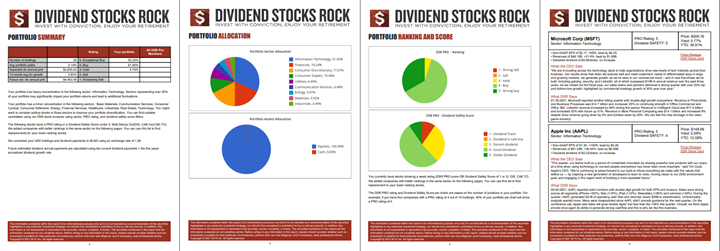
Download my portfolio Q4 2023 report.
Dividend Income: $419.95 CAD (+5% vs February 2023)
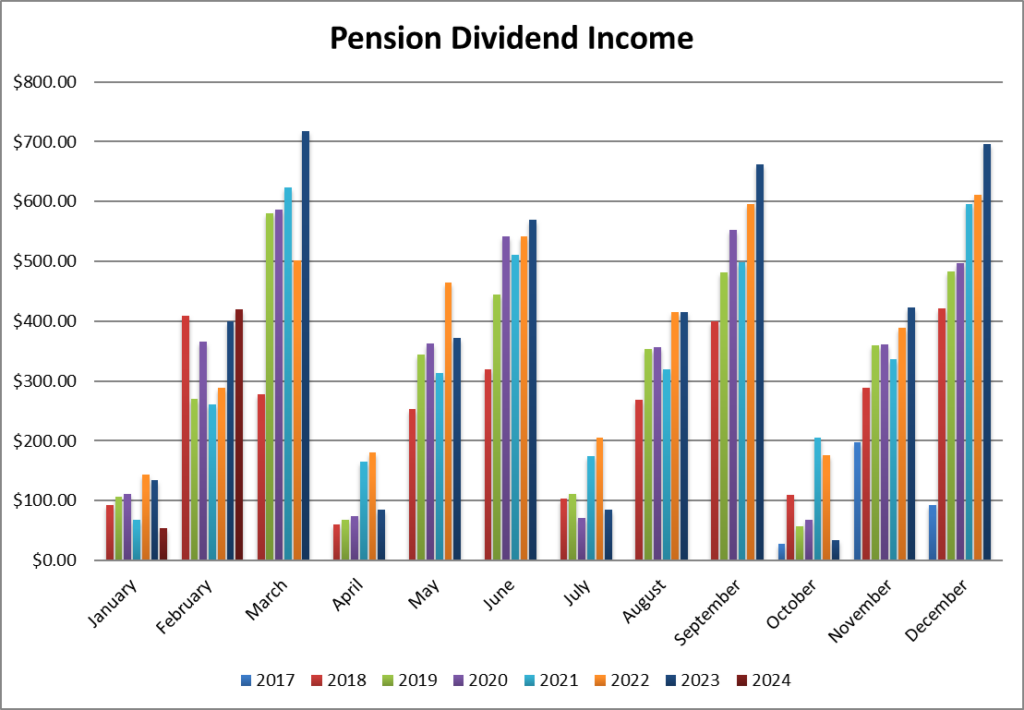
This was a good month for dividends, my best one for the month of February. The dividend growth was driven by Canadian banks (National bank and Royal) and all companies show a higher dividend payment than last year. I sold some shares of Apple at the end of 2023 which partially offset my dividend income for this month.
Dividend growth (over the past 12 months):
- Granite: +3.13%
- Royal Bank: +13.26%
- National Bank: +9.28%
- Starbucks: +7.55%
- Apple: -44.35% (I sold shares of AAPL)
- Texas Instruments: +4.84%
- Currency: -0.006%
Canadian Holding payouts: $253.17 CAD.
- Granite: $35.21
- Royal Bank: $89.70
- National Bank: $128.26
U.S. Holding payouts: $123.05 USD.
- Starbucks: $48.45
- Apple: $9.60
- Texas Instruments: $65.00
Total payouts: $419.95 CAD.
*I used a USD/CAD conversion rate of 1.3554
Since I started this portfolio in September 2017, I have received a total of $24,586.88 CAD in dividends. Keep in mind that this is a “pure dividend growth portfolio” as no capital can be added to this account other than retained and/or reinvested dividends. Therefore, all dividend growth is coming from the stocks and not from any additional capital being added to the account.
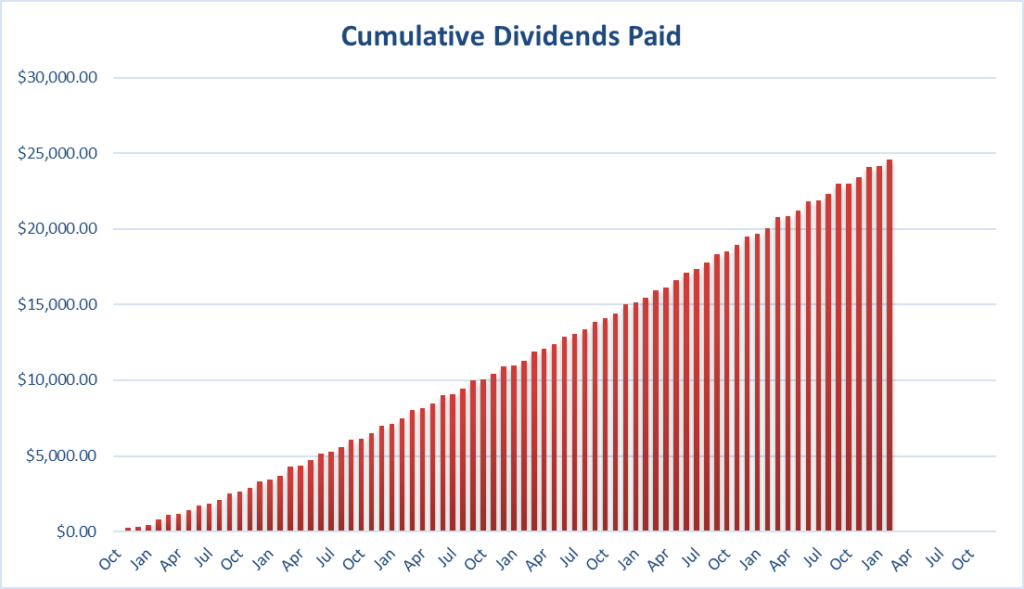
Final Thoughts
Save Your Spot to Our Next Webinar on Investing at All-Time High Market!
On Thursday, March 21st, I’ll be hosting a free webinar on positioning your portfolio in an all-time-high market.
After this webinar, you should be able to:
After this webinar, you should be able to:
- Make the difference between price anchoring and sound valuation.
- Fight your fear of investing now and losing money.
- Get the deal you are looking for.
- Buy dividend stocks in an overvalued market without getting burned.
Here are the complete details:
- The webinar is on Thursday, March 21st at 1pm ET.
- It is 100% free, no strings attached.
- The presentation is about 50 minutes.
- I’ll stay for one hour to answer all your questions.
- I’ll provide the handouts to all live attendees.
- A free replay link will be sent to all registered attendees.
Prepare your questions. This webinar is about 50 minutes long, and I will answer all your questions about stocks, strategies, and the economy afterward.
Going forward, being cautiously optimistic should be the new buzzword. I must admit: seeing the overall market valuation at such levels makes me think twice about my next move. However, I follow a strict process where I sell my winners when they become too big. This process enables me to take profits when they are juicy and reallocate the proceeds toward better diversification.
I will never sell to go cash, but I’m thinking about trimming more aggressively some positions as the year advances. I have entertained this possibility, but I’m not ready to pull the trigger yet. As you are aware of my process, I like to take mental note and reflect on them for a few months or often until the end of the year. I don’t make rash decisions with my portfolio and it has served me well so far.
Cheers,
Mike.
The post Markets Performance Review – February Dividend Income Report appeared first on The Dividend Guy Blog.
© Copyright 2013 Adividend
